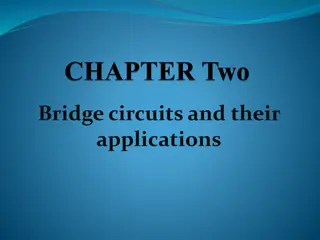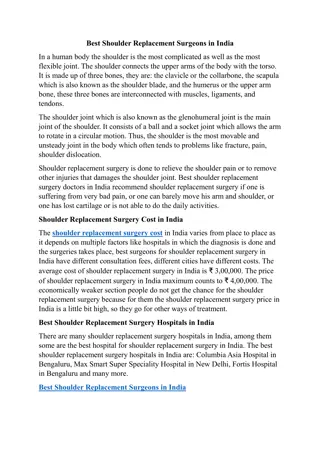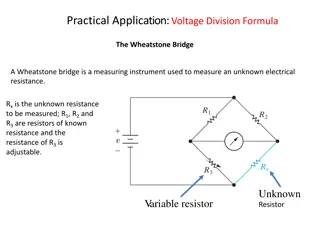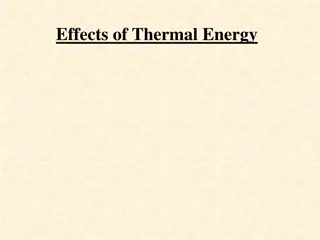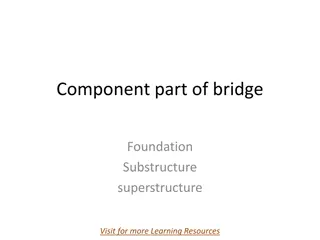BRIDGE EXPANSION JOINT
Bridge expansion joints are crucial components that provide continuity between different parts of bridge structures, accommodating movements caused by various factors like thermal deformation and traffic loads. They come in different types based on movement ranges and construction methods, such as small movement joints like sliding plate joints, compression seal joints, asphaltic plug joints, and poured sealant joints. Each type has its advantages and disadvantages, making them suitable for different bridge design requirements.
Download Presentation

Please find below an Image/Link to download the presentation.
The content on the website is provided AS IS for your information and personal use only. It may not be sold, licensed, or shared on other websites without obtaining consent from the author. Download presentation by click this link. If you encounter any issues during the download, it is possible that the publisher has removed the file from their server.
E N D
Presentation Transcript
INTRODUCTION Generally Expansion Joints of Bridges are designed to provide continuity between two parts of the structures which are in relative movements because of thermal deformation, creep, shrinkage and displacement/deflection of the structures under traffic load. Expansion Joints should be capable of accommodating all movements of the deck slab.
TYPE OF EXPANSION JOINT BASED ON MOVEMENT Small Movement Joints: capable of accommodating total motion up to 45 mm. Medium Movement Joints: capable of accommodating total motion 45 mm to 130 mm. Large Movement Joints: capable of accommodating total motion excess of 130 mm.
TYPE OF SMALL MOVEMENT JOINT (Based On Construction) Sliding Plate joints Compression Seal Joints Asphaltic Plug Joints Poured Sealant Joints
SLIDING PLATE JOINT Advantages: 1. Sliding Plate Joints are used for short and medium span bridges. These Joints are structurally simple, reasonable in cost. 2. Disadvantages: 1. These are limited to horizontal movement and there would be no movement. Plates need to be adjusted periodically to reduce noise level. The corrosion of plates and debris collected may result in jamming of the joint preventing the free movement of superstructure. differential vertical 2. 3.
COMPRESSION SEAL JOINT Advantages: inexpensive and easy to replace. These seals are versatile, relatively Disadvantages: 1. For wider joints, adherence of the seal to the sides of the joint throughout the length is difficult. Not suitable for deck slab with a large skew and curvature. 2.
ASPHALTIC PLUG JOINT Advantages: 1. They provide smooth roadway surface for traffic. 2. They are water tight and snow proof. 3. There is no debris collection at the top of the joint. Disadvantages: 1. Not suitable in cold areas where lowest temperature is below Transition temperature of APJ material. 2. Generally limited to the skew angle below 30 degrees. 3. Can not accommodate displacement. differential vertical
POURED SEALANT JOINT Advantages: 1. Easy to use and self leveling. 2. Can be placed in a short time so suitable for rehabilitation/repair project. 3. Exhibit good elastic properties over a wide range of temperature variation. Disadvantages: 1. It s a temporary type of joint system(8-10 years) and mainly used for bridge rehabilitation projects where it is difficult to replace existing seals. 2. Very sensitive to field installation conditions, such as workmanship.
TYPE OF MEDIUM MOVEMENT JOINT (Based On Construction) Strip Seal joints Finger Plate Joints
STRIP SEAL JOINT Advantages: 1. Properly installed strip seals have demonstrated relatively good performance. 2. Damage seals can be replaced with minimum traffic disruptions. Disadvantages: 1. Accumulates movement and result in a premature seal failure. debris which can resist joint 2. Faulty installations or unclean locking devices cause seal pullout from metallic rail edges.
FINGER PLATE JOINT Advantages: 1. It can accommodate all movements of the structure both horizontal and vertical. 2. Successfully used in medium and long span bridges. 3. It has a good riding quality without causing any hazards to any class of road users. 4. Silent and skid & vibration free in operation. 5. It allows easy inspection, maintenance, repair or replacement. Disadvantages: Finger Plate joints allow water and de- icing chemical to pass through them. Elastomeric or metallic seal must be placed beneath them to intercept the deck water and debris way from the substructure member.
TYPE OF LARGE MOVEMENT JOINT (Based On Construction) Bolt-Down Panel Joints Modular Elastomeric Seal Joints
BOLT-DOWN JOINT Advantages: Bolt-down panels can be fabricated in varying widths proportional to the total allowable movement range. Elastomericdam Disadvantages: Bolts and nuts connecting panel to bridge decks are prone to loosening and breaking under high speed traffic. The loose panels and hardware in the roadway vehicular traffic, particularly to motorcycles. present hazards to
MODULAR ELASTOMERIC SEAL JOINT Advantages: These joints provide watertight and vehicular load transfer expansion joint openings and performance of these joints at many locations have been found satisfactory. across a wide Disadvantages: These devices are structurally complex and very expensive.
Reference Beam Reference Beam Block-out area after deck slabs concreting Prepare the Block-out area Reference Beam Installation
Placing Steel Profile Sealer Strip Placing Cross Beam for level adjustment of Steel Profile
Level adjustment Center line checking Level checking
Installing of Anchor Bolt After installation Anchor Bolt Final Level checking by Level Machine
Welding of rectangular anchor bar with Steel Profile After installation and welding of anchor bar
Welding Anchor Bolt with anchor Rebar Welding extra cut piece rebar with Anchor Bolt & anchor Rebar
Cleaning by Air Compressor Cleaning by Water Formwork placing for Expansion Gap
Rubber Seal placing on Steel Profile Rubber Seal installation by hand
Rubber Seal installation by Crowbar After installation Rubber Seal
Concreting in Block-out area (Concrete Class C-50) Concreting up to the level of Steel Profile
Tightening Anchor Bolt by Electric Wrench Placing Finger Plate Tightening Anchor Bolt by Hand Wrench
WHY USED? Contraction Joint is used to reduce thereby reducing cost and increasing driving comfort . the number of expansion joint, It allows only contraction of deck slab while the expansion joint allows both expansion and contraction.
Dowel Bars Debonding coat will be provided at dowel bars before concreting adjacent deck slab Contraction Joint after concreting deck slab(one side)


